Sebuah paket adalah pengelompokan elemen model yang berarti bahwa sebuah paket dapat berisi elemen model dari berbagai jenis, termasuk paket lain untuk membuat hierarki. Sebuah paket mendefinisikan ruang nama untuk isinya untuk berbagai tujuan.
Diagram Paket Sekilas
Diagram paket digunakan untuk menyederhanakan diagram kelas yang kompleks, Anda dapat mengelompokkan kelas ke dalam paket. Sebuah paket adalah kumpulan elemen UML yang secara logis terkait.
Diagram di bawah ini adalah model bisnis di mana kelas-kelas dikelompokkan ke dalam paket:
- Paket muncul sebagai persegi panjang dengan tab kecil di bagian atas.
- Nama paket berada di tab atau di dalam persegi panjang.
- Garis putus-putus adalah ketergantungan.
- Satu paket bergantung pada paket lain jika perubahan pada yang lain dapat memaksa perubahan pada yang pertama.
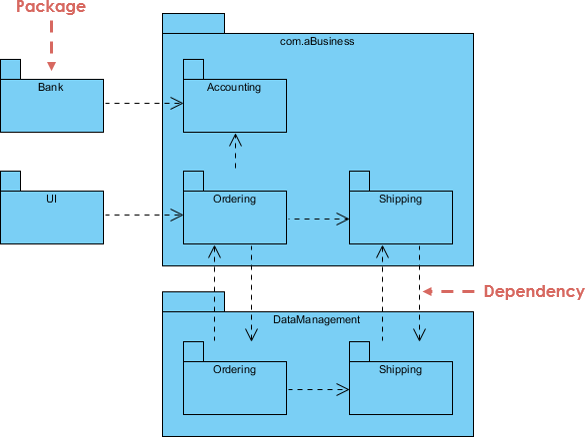
Konsep Dasar Diagram Paket
Diagram paket mengikuti struktur hierarkis dari paket bersarang. Modul atom untuk paket bersarang biasanya adalah diagram kelas. Ada beberapa batasan saat menggunakan diagram paket, yaitu sebagai berikut.
- Nama paket tidak boleh sama untuk sebuah sistem, namun kelas di dalam paket yang berbeda dapat memiliki nama yang sama.
- Paket dapat mencakup seluruh diagram, nama komponen saja atau tidak ada komponen sama sekali.
- Nama lengkap dari sebuah paket memiliki sintaksis sebagai berikut.

Paket dapat direpresentasikan oleh notasi dengan beberapa contoh yang ditunjukkan di bawah ini:
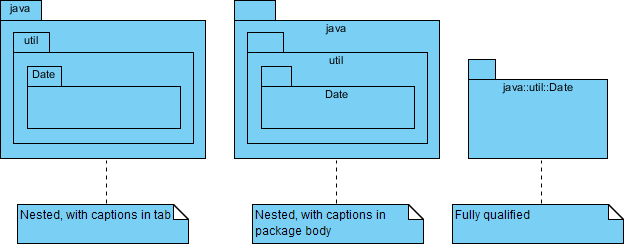
Diagram Paket — Notasi Ketergantungan
Ada dua sub-tipe yang terlibat dalam ketergantungan. Mereka adalah <<impor>> & <<akses>>. Meskipun ada dua stereotip, pengguna dapat menggunakan stereotip mereka sendiri untuk merepresentasikan jenis ketergantungan antara dua paket.
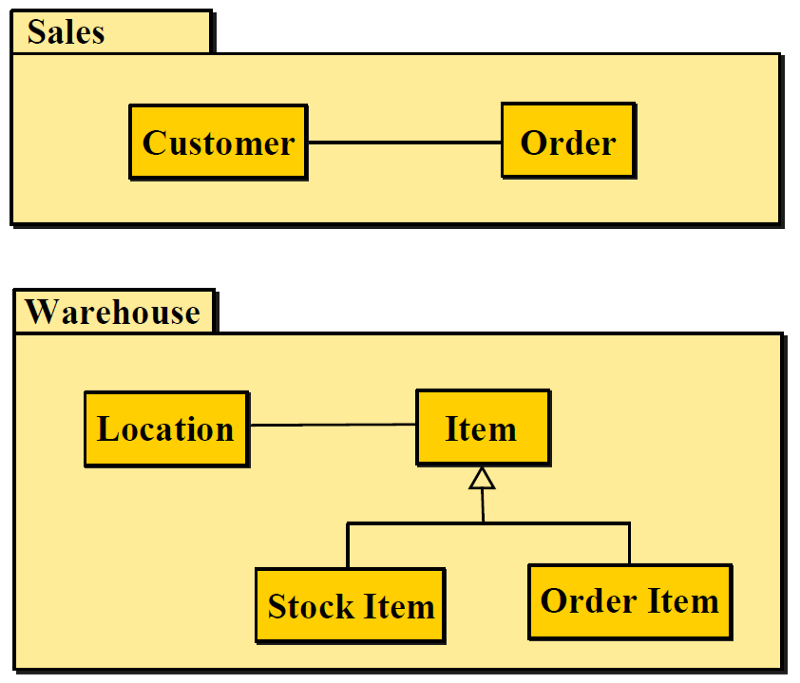
Elemen Kunci Diagram Paket
Paket digunakan untuk mengorganisir sekumpulan besar elemen model:
- Visibilitas
- Impor
- Akses
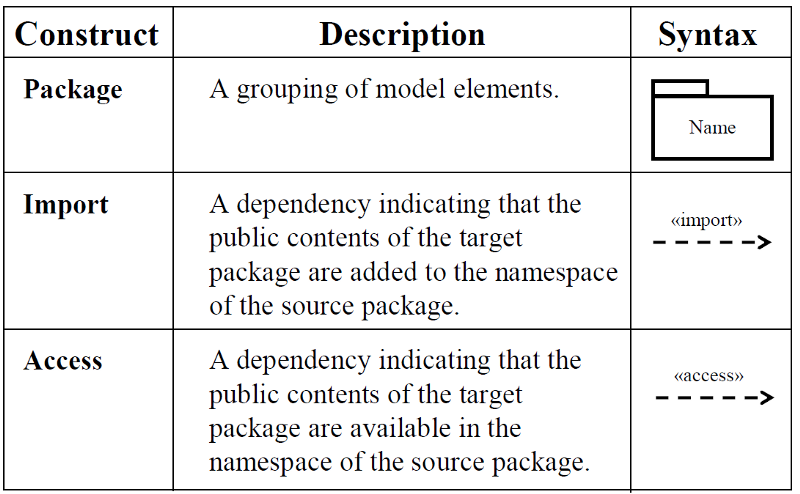
Kapan Menggunakan Paket?
Untuk membuat gambaran umum dari sekumpulan besar elemen model
- Untuk mengorganisir model besar
- Untuk mengelompokkan elemen yang terkait
- Untuk memisahkan ruang nama
Visibilitas Paket
Setiap elemen yang terkandung memiliki visibilitas relatif terhadap paket yang mengandungnya.
- Elemen publik terlihat oleh elemen di luar paket, ditandai dengan ‘+’
- Elemen yang dilindungi hanya terlihat oleh elemen dalam paket yang mewarisi, ditandai dengan ‘#’
- Elemen privat sama sekali tidak terlihat oleh elemen di luar paket, ditandai dengan ‘-’
- Sintaksis yang sama untuk visibilitas atribut dan operasi dalam kelas
Hubungan Impor antara Paket
Asosiasi dimiliki oleh paket X:
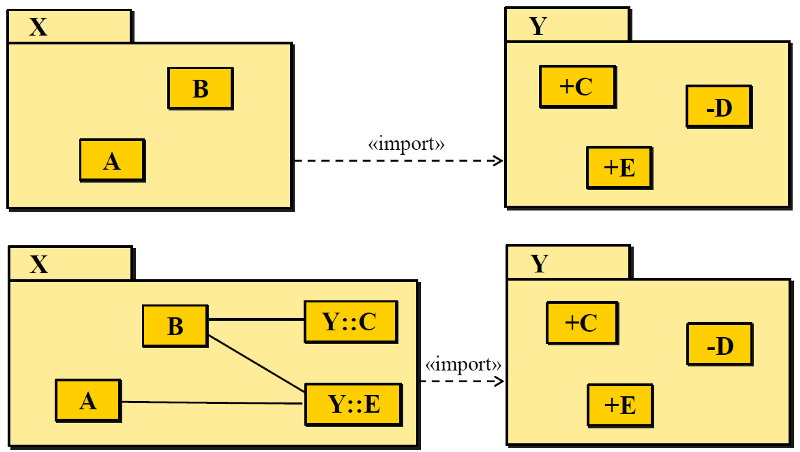
Impor dan Akses
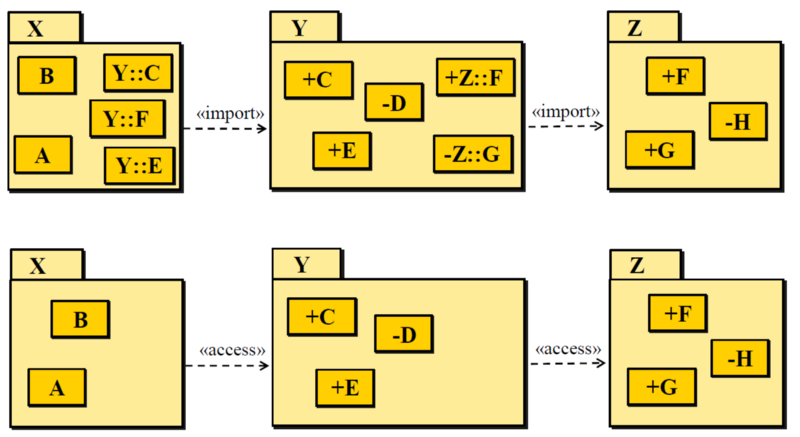
Pewarisan
Sebuah paket dengan generalisasi ke paket lain mewarisi elemen publik dan dilindungi yang dimiliki atau diimpor oleh paket yang diwarisi. Paket ditampilkan dalam diagram statis dengan dua cara setara untuk menunjukkan konten:
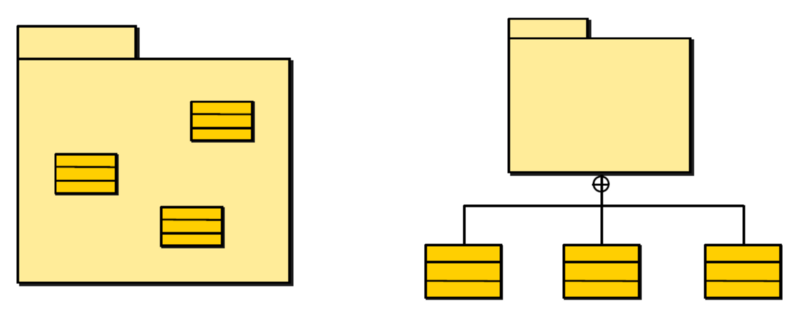
Sub-sistem
Sub-sistem digunakan untuk dekomposisi sistem yang dapat direpresentasikan oleh bagian-bagian dari sebuah sistem: (Spesifikasi / Realisasi)
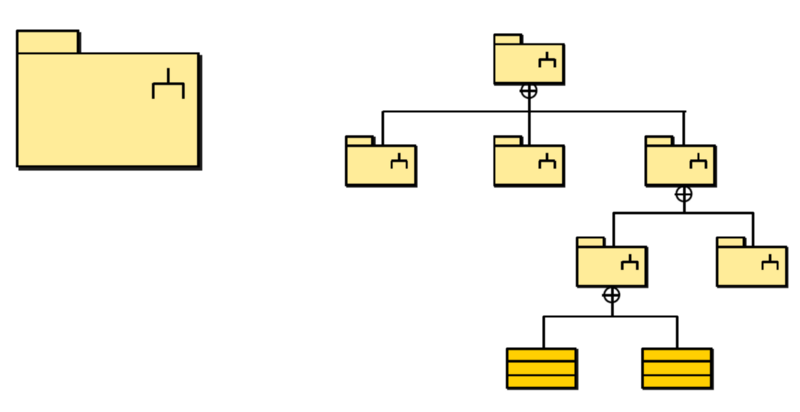
Aspek Internal dan Eksternal Sub-sistem
Sebuah sub-sistem memiliki spesifikasi dan realisasi untuk merepresentasikan dua pandangan:
- Pandangan eksternal, menunjukkan layanan yang disediakan oleh sub-sistem
- Pandangan internal, menunjukkan realisasi dari sub-sistem
- Ada pemetaan antara kedua aspek
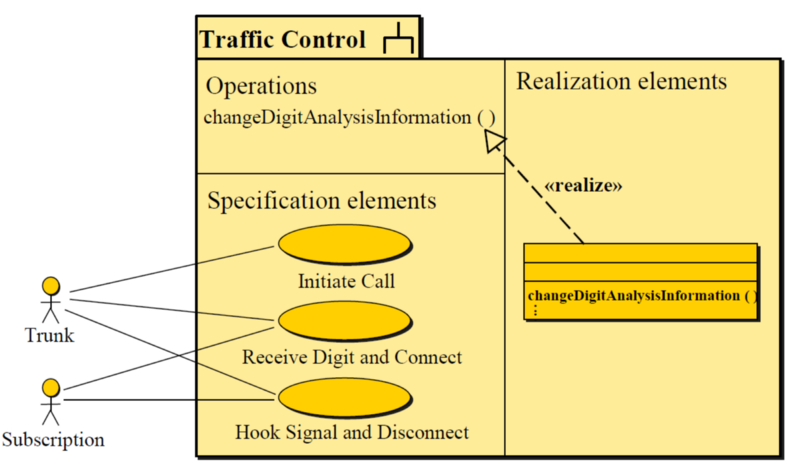
Tips Pemodelan Sub-sistem
- Tentukan sub-sistem untuk setiap bagian terpisah dari sistem besar
- Pilih teknik spesifikasi tergantung pada faktor seperti jenis sistem dan jenis sub-sistem
- Realisasikan setiap sub-sistem secara independen, menggunakan spesifikasi sebagai spesifikasi kebutuhan
Pemodelan Pengelompokan Kompleks
Diagram paket sering digunakan untuk menggambarkan hubungan hierarkis (pengelompokan) antara paket dan paket atau objek lainnya. Sebuah paket mewakili ruang nama.
Contoh Diagram Paket — Struktur Berlapis
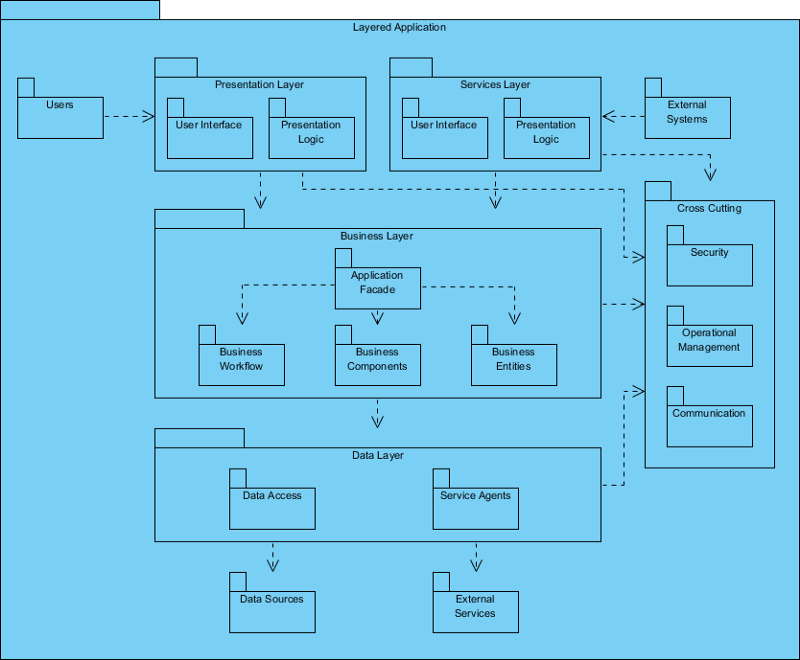
Cobalah sendiri dan bersenang-senanglah dengan Visual Paradigm Online
Visual Paradigm online (Edisi Ekspres GRATIS)
- Contoh dan template Diagram Paket gratis yang dapat diedit dalam perangkat lunak Diagram Paket online: Visual Paradigm Online.
- Gunakan template sebagai titik awal untuk membuat Diagram Paket Anda sendiri.
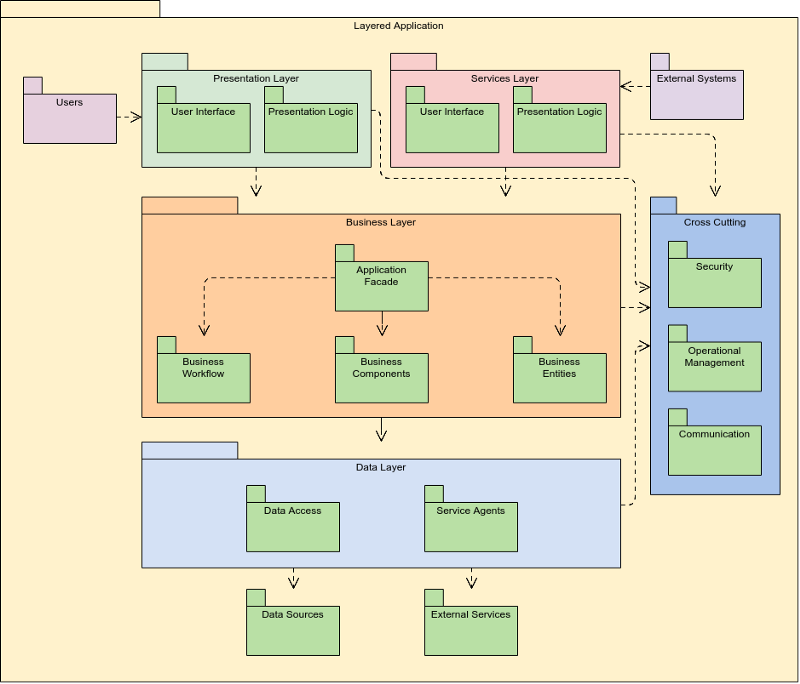

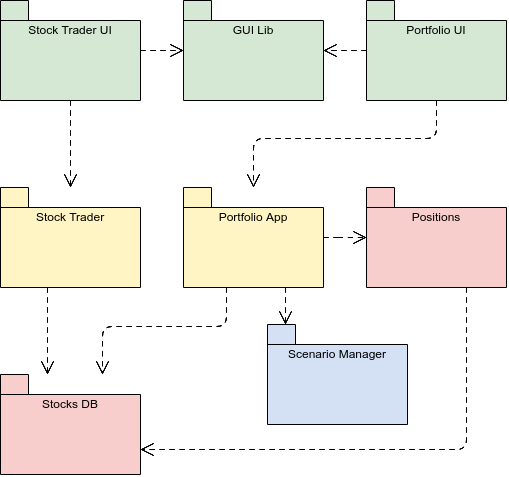
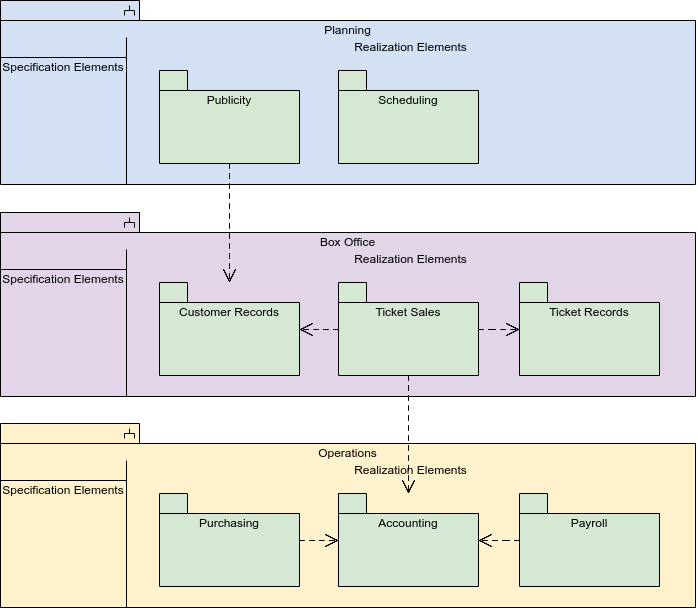
This post is also available in Deutsch, English, Español, فارسی, Français, 日本語, Polski, Portuguese, Ру́сский, Việt Nam, 简体中文 and 繁體中文.













